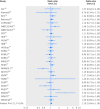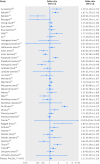Long working hours and alcohol use: systematic review and meta-analysis of published studies and unpublished individual participant data
- PMID: 25587065
- PMCID: PMC4293546
- DOI: 10.1136/bmj.g7772
Long working hours and alcohol use: systematic review and meta-analysis of published studies and unpublished individual participant data
Abstract
Objective: To quantify the association between long working hours and alcohol use.
Design: Systematic review and meta-analysis of published studies and unpublished individual participant data.
Data sources: A systematic search of PubMed and Embase databases in April 2014 for published studies, supplemented with manual searches. Unpublished individual participant data were obtained from 27 additional studies.
Review methods: The search strategy was designed to retrieve cross sectional and prospective studies of the association between long working hours and alcohol use. Summary estimates were obtained with random effects meta-analysis. Sources of heterogeneity were examined with meta-regression.
Results: Cross sectional analysis was based on 61 studies representing 333,693 participants from 14 countries. Prospective analysis was based on 20 studies representing 100,602 participants from nine countries. The pooled maximum adjusted odds ratio for the association between long working hours and alcohol use was 1.11 (95% confidence interval 1.05 to 1.18) in the cross sectional analysis of published and unpublished data. Odds ratio of new onset risky alcohol use was 1.12 (1.04 to 1.20) in the analysis of prospective published and unpublished data. In the 18 studies with individual participant data it was possible to assess the European Union Working Time Directive, which recommends an upper limit of 48 hours a week. Odds ratios of new onset risky alcohol use for those working 49-54 hours and ≥ 55 hours a week were 1.13 (1.02 to 1.26; adjusted difference in incidence 0.8 percentage points) and 1.12 (1.01 to 1.25; adjusted difference in incidence 0.7 percentage points), respectively, compared with working standard 35-40 hours (incidence of new onset risky alcohol use 6.2%). There was no difference in these associations between men and women or by age or socioeconomic groups, geographical regions, sample type (population based v occupational cohort), prevalence of risky alcohol use in the cohort, or sample attrition rate.
Conclusions: Individuals whose working hours exceed standard recommendations are more likely to increase their alcohol use to levels that pose a health risk.
© Virtanen et al 2015.
Conflict of interest statement
Competing interests: All authors have completed the ICMJE uniform disclosure form at
Figures







Comment in
-
Long working hours are linked to risky alcohol consumption.BMJ. 2015 Jan 13;350:g7800. doi: 10.1136/bmj.g7800. BMJ. 2015. PMID: 25587066 No abstract available.
References
-
- World Health Organization. Global status report on alcohol and health 2014. WHO, 2014.
-
- Friedmann PD. Clinical practice. Alcohol use in adults. N Engl J Med 2013;368:365-73. - PubMed
-
- Alcohol in the workplace. Institute of Alcohol Studies (IAS), 2014.
-
- Nicholson P, Mayho G, Sharp C. Alcohol, drugs and the workplace. The role of medical professionals. A briefing from the BMA Occupational Medicine Committee. BMA, 2014.
-
- International Centre for Alcohol Policies. International drinking guidelines, 2010.
Publication types
MeSH terms
Grants and funding
LinkOut - more resources
Full Text Sources
Other Literature Sources
Medical
Miscellaneous
